Roundup of research by INBT’s summer undergraduate researchers
Johns Hopkins Institute for NanoBioTechnology hosted 17 undergraduates from universities nationwide in to conduct research in Hopkins laboratories. Of the total, three students were affiliated with the Center of Cancer Nanotechnology Excellence (CCNE), four were affiliated with the Physical Sciences-Oncology Center (PS-OC), and the remaining 10 were funded in part by the National Science Foundation Research Experience for Undergraduates program. INBT, served as a hub for their academic and social activities.
INBT summer interns conduct 10 weeks of research in a laboratory either on the Homewood or the medical campus of the University. At the end of that time, students have learned how to work in a multidisciplinary team and how to manage a short term research project. They also discover if research is a pathway they want to pursue after earning their bachelor’s degrees. Students also present their work in a university wide poster session.
So what were our summer visitors doing? Here are short summaries of the research conducted by each student.
Amani Alkayyali (Wayne State Univeristy)
Lab: Honggang Cui, Dept. of Chemical and Biomolecular Engineering, REU
Amani tried different concentrations of two different peptide conjugates toward the creation of a self-assembling nano-filament that would remain outside of blood cells yet become part of a hemoglobin-based drug delivery vehicle.
Jacqueline Carozza (Cornell University)
Lab: Denis Wirtz, Dept. of Chemical and Biomolecular Engineering, PS-OC
Jacqueline used high throughput cell phenotyping techniques developed in the Wirtz lab to investigate the physical differences in a variety of cancer cell lines in response to varying concentrations of the cancer drug doxorubicin.
Eric Do (University of Washington, Seattle)
Lab: Margarita Herrera-Alonso, Dept. of Materials Science and Engineering, REU
Eric worked on developing nanoparticles that could encapsulate semiconducting polymers, which have been shown to have a lower toxicity to cells than quantum dots, for the purpose of developing a safer in vivo fluorescent imaging technology.
Matthew Fong (University of California, Berkeley)
Lab: Honggang Cui, Dept. of Chemical and Biomolecular Engineering, CCNE
Matthew worked on pairing the chemotherapy drug Paclitaxel with a vesicle engineered of a peptide amphiphile to create a 3D nanostructure that would improve the drugs solubility and control the timed release of the drug.
Olivia Hentz (Cornell University)
Lab: Jonah Erlebacher, Dept. of Materials Science and Engineering, REU
Olivia used gold as a template to create hollow polymer nanoparticles in both spherical and rod shapes and examined their ability to transfect gene-silencing RNA into living cells under various conditions.
Michelle LaComb (Rice University)
Lab: Honggang Cui, Dept. of Chemical and Biomolecular Engineering, REU
Michelle studied the self-assembly patterns of folic acid, an essential vitamin to humans, in various solutions. Cancer cells often express a high number of folic acid receptors, so folic acid could play a role in targeted cancer therapies.
Bianca Lascano (Norfolk State University)
Lab: Jordan Green, Dept. of Biomedical Engineering, REU
Bianca conducted in vitro tests on a library of poly beta-amino esters for their ability to non-virally transfect a fluorescent reporter gene into a dendritic cell.
Lauren Lee (Cornell University)
Lab: Hai-Quan Mao, Dept. of Materials Science and Engineering, REU
Lauren tested the migration response of immortalized Schwann cells growing within an engineered hydrogel containing neurotrophic growth factors positioned along a physical and chemical gradient.
Anthony Loder (Rowan State University)
Lab: Xin Chen, Dept. of Biology. REU
Using stem cells from Drosophila, Anthony looked at the differentiation and proliferation and examined how Enhancer of Zeste histone methyl-transferase was involved in regulating the process.
Cassandra “Casie” Loren (Oregon State University)
Lab: Denis Wirtz, Dept. of Chemical and Biomolecular Engineering, PS-OC
Casie used high throughput cell phenotyping techniques developed in the Wirtz lab to examine the physical characteristics of cells growing through various life cycle stages, particularly quiescence or cell inactivity.
Albert Lu (University of California, Berkeley)
Lab: Jeff Wang, Dept. of Biomedical Engineering, CCNE
Albert used E. coli to perform limit-of-detection evaluations of a lab-on-a-chip device designed to quickly screen for pathogens in biological samples.
Bria Macklin (Howard University)
Lab: Sharon Gerecht, Dept. of Chemical and Biomolecular Engineering, REU
With various growth factors, Bria optimized a collagen-based medium in which to grow endothelial cells.
Daniel McClelland (Bethany College)
Lab: D. Howard Fairbrother, Dept. of Chemistry, REU
Daniel tested the effect of carbon nanotube-polymer composites on the biofilm attachment and viability of Pseudomonas aeruginosa, which is a common soil and water. The study related to the biodegradation of carbon nanotubes.
Edwin “Charlie” Nusbaum (The Richard Stockton College of New Jersey)
Lab: Robert Ivkov, Dept. of Radiation Oncology, REU
Hyperthermia, or heating cells above normal body temperatures, could be used in cancer treatment, but heat to surrounding healthy tissues and organs would be detrimental. Charlie showed that copper could be used to calibrate alternating magnetic field hypothermia with magnetic nanoparticles at radiofrequencies.
Josh Porterfield (Cornell University)
Lab: Sharon Gerecht, Dept. of Chemical and Biomolecular Engineering, PS-OC
Josh studied the influence of a transcription factor associated with the formation of blood vessels in breast cancer tumors called HEYL on the patterns of vascularization in extracellular matrix.
Justin Samorajski (University of Dallas)
Lab: Peter Searson, Dept. of Materials Science and Engineering, CCNE
Using a two-layer microfluidic device, Justin examined the effect of an electrical field gradient on the migration of fibrosarcoma cells in 3D.
Carolyn Zhang (University of California, San Diego)
Lab: Sharon Gerecht/Hai Quan Mao, Dept. of Chemical and Biomolecular Engineering, PS-OC
Constructing a framework from fibrin developed in the Mao lab, Carolyn worked on optimizing a template containing a growth factor gradient upon which endothelial colony forming cells could establish a tubular structure of viable cells.
Story by Mary Spiro
Related links:
Meet INBT’s summer interns, already digging into their research – 06/28/12
Summer interns present research work at Aug. 2 poster session
Latest Posts
-
 Q&A with PSON Intern Jocelyn Hsu
August 19, 2021
Q&A with PSON Intern Jocelyn Hsu
August 19, 2021
-
 Start Up Founders from Johns Hopkins Aim to Stop Spread of Cancer
August 3, 2021
Start Up Founders from Johns Hopkins Aim to Stop Spread of Cancer
August 3, 2021
-
 Protein Appears to Prevent Tumor Cells from Spreading Via Blood Vessels
July 15, 2021
Protein Appears to Prevent Tumor Cells from Spreading Via Blood Vessels
July 15, 2021


